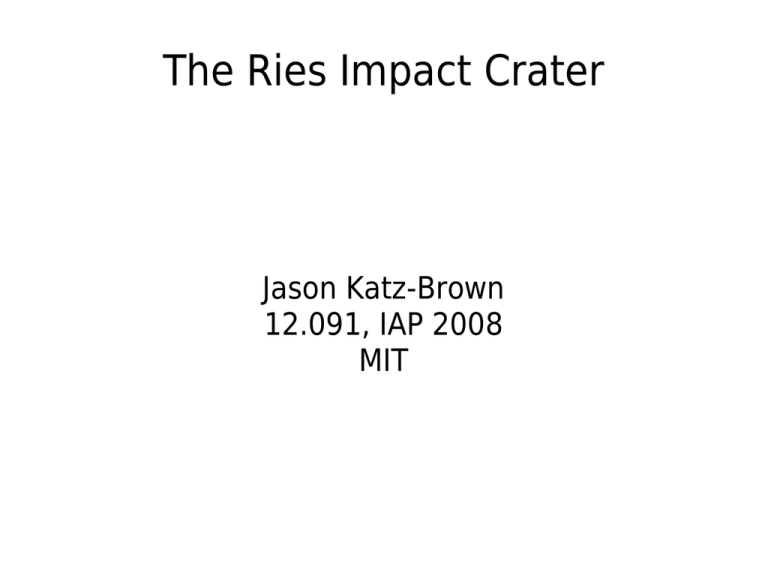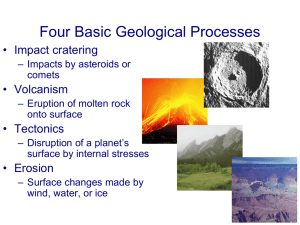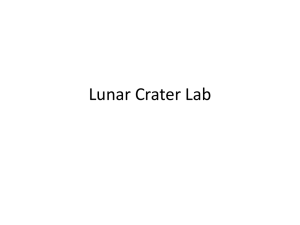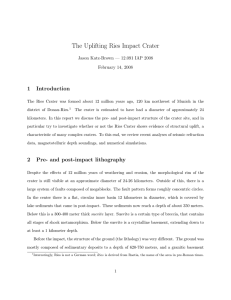Document 13515576
advertisement

The Ries Impact Crater Jason Katz-Brown 12.091, IAP 2008 MIT Time and location ● ● Formed 12 Ma ago (Miocene) 120 km northwest of Munich in the district of Donau-Ries. Ries Crater [http://www.unb.ca/passc/ImpactDatabase/EuropeMap.jpg] [http://www.unb.ca/passc/ImpactDatabase/images/ries-105.jpg] ● Suevite (type of impact breccia) quarry in NE of crater [http://www.unb.ca/passc/ImpactDatabase/images/ries-100.jpg] ● Aerial view [http://www.unb.ca/passc/ImpactDatabase/images/ries-103.jpg] Image licensed under Attribution-Share Alike 2.0 Austria; http://en.wikipedia.org/wiki/Image:Ries_Crater_Rim.jpg Photographer H. Raab. ● Crater rim Inner basin ● Almost circular, relatively flat, inner basin ● 150 m below surface at center. ● 12 km in diameter. ● Covered by postimpact lake sediments. Crater rim ● Outside the inner rim, a system of concentric faults extending to a diameter of 24 to 26 km. ● Referred to as displaced megablocks. ● “hummocky”! Preimpact layerage ● Sedimentary deposits 620-750m thick ● Crystalline, mainly granitic, basement Postimpact layerage ● 0-350m down: Post-impact lake sediments. ● 350-750m down: thick suevite layer – Suevite: “a polymict clastic breccia primarily derived from crystalline basement containing all stages of shock metamorphism, including melt.” Impact ● ● Immediately after meteorite hit, transient crater formed of roughly 4 km deep. Unclear what caused the crater floor to be only 1 km deep. – Structural uplift, characteristic of many complex craters? Analysis and Modeling ● Wünnemann, Morgan, and Jödicke of Imperial College and Institut für Geophysik reanalyzed data collected from Ries in the 1970s with modern analysis techniques – Seismic refraction data – Magnetotelluric – Numerical depth soundings simulations Structural uplift ● Structural uplift associated with – increase in seismic velocity – increase in density – change ● in the magnetic or electrical signature Wünnemann et al. reanalyzed seismic refraction data to investigate whether there is an increase in seismic velocity. [Wünnemann et al., Figure 2] [Wünnemann et al., Figure 3] 6.0 m/s velocity boundary is reached at different depths inside crater and outside crater, suggesting structural uplift. <- Inside crater <- Outside crater Magnetotelluric Investigation ● ● ● Wünnemann et al. further studied the distribution of electrical conductivity of the deep structure below the Ries crater by means of magnetotelluric (MT) measurements. The MT method is used to detect highly conductive structures in deep subsurface. Used measurements over a 73 km profile, with spacing of about 5 km between measurements. ● [Wünnemann et al., Figure 5] Note: slant of area of high conductivity to left, Model III excludes deepreaching fractures below crater. Numerical Simulation ● Wünnemann et al. finally used the well-known SALE hydrocode with these parameters: – Rock: yield strength, pressure, temperature, internal friction, cohesion – Acoustic ● fluidization: viscosity, decay time Strongly linked with fragmentation size of rocks underneath structure. ● [Wünnemann et al., Figure 7] Main conclusion I took away was that the top layer is composed of melt-rich material that corresponds to the suevite layer. [Wünnemann et al., Figure 8] ● Wow, >50 Gpa is a lot of pressure. References ● ● ● K Wünnemann, JV Morgan, H Jödicke. Is Ries crater typical for its size? An analysis based upon old and new geophysical data and numerical modeling. In: T. Kenkmann, F. Hörz and A. Deutsch, Editors, Large Meteorite Impacts III, Geol. Soc. Am., Boulder, CO (2005), pp. 67–83 Special Paper 384. R.M. Hough, I. Gilmour, C.T. Pillinger, J.W. Arden, R.W.R. Gilkes, J. Yuan and H.J. Milledge, Diamond and silicon carbide in impact melt rock from the Ries impact crater. Nature 378 (1995), pp. 41–44. Graup, Genther. Carbonate-silicate liquid immiscibility upon impact melting, Ries Crater, Germany. Meteoritics & Planetary Science, vol. 34, no. 3, pp. 425-438 (1999).




